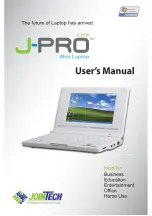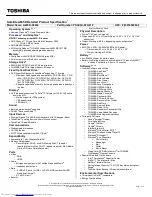
22
Chapter 1
Item (NB Cont.)
Features
•
Hardware cursor up to 64x64 pixels in 2 bpp, full color AND/XOR mix,
and full color 8-bit alpha blend.
•
Hardware icon up to 128x128 pixels in 2 bpp, with two colors,
transparent, and inverse transparent. AND/XOR mixing. Supports 2x2
icon magnification.
•
Virtual desktop support.
•
Support for flat panel displays via VGA.
VGA Output
•
Maximum resolutions supported by the VGA output for different refresh
rates are:
•
2048x1536 @85Hz (pixel clock at 388.5MHz) for 4:3 format
•
2560x1440 @75Hz (pixel clock at 397.25MHz) for 16:9 format
•
2456x1536 @60Hz (pixel clock at 320MHz) for 16:10 format
•
1.3.10 Integrated LVDS Interface
•
Integrated dual-link 24-bit LVDS interface.
•
805 Mbps/channel with 115 MHz pixel clock rate per link (230 MHz
maximum pixel clock).
•
FPDI-2 compliant; compatible with receivers from National
Semiconductor, Texas Instruments, and THine.
•
OpenLDI compliant excluding DC balancing.
•
Programmable internal spread spectrum controller for the signals.
System Clocks
•
Support for an external clock chip to generate side-port memory, PCIe,
and A-Link Express II clocks. Alternatively, internal generation for these
clocks, with clock input from an SB800-series Southbridge, can be
used (subject to characterization with actual RS880M and SB800-
series devices).
Power Management Features
•
Single chip solution in 55nm, 1.1V CMOS technology.
•
Supports ACPI 2.0 for S0, S3, S4, and S5 states.
•
Full IAPC (Instantly Available PC) power management support.
•
Static and dynamic power management support (APM as well as ACPI)
with full VESA DPM and Energy Star compliance.
•
The Chip Power Management Support logic supports four device power
states defined for the OnNow Architecture - On, Standby, Suspend, and
Off. Each power state can be achieved by software control bits.
•
Hardware controlled intelligent clock gating enables clocks only to
active functional blocks, and is completely transparent to software.
•
Support for Cool'n'Quiet. via FID/VID change.
•
Support for AMD PowerNow!
•
Clocks to every major functional block are controlled by a unique
dynamic clock switching technique that is completely transparent to the
software. By turning off the clock to the block that is idle or not used at
that point, the power consumption can be significantly reduced during
normal operation.
•
Supports AMD Vari-Bright., ATI PowerXpress., and ATI PowerPlay.
(enhanced with the ATI PowerShift. feature).
•
Supports dynamic lane reduction for the PCIe graphics interface when
coupled with an AMD-based graphics device, PC Design Guide
Compliance.
Содержание ASPIRE 553G
Страница 6: ...VI ...
Страница 10: ...X Table of Contents ...
Страница 42: ...32 Chapter 1 ...
Страница 67: ...Chapter 3 57 4 Lift the base door out and away ...
Страница 72: ...62 Chapter 3 5 Pull the WLAN module out and away ...
Страница 80: ...70 Chapter 3 8 Flip the keyboard over 9 Detach the keyboard FPC a Unlock the FPC b Pull the keyboard away a b ...
Страница 86: ...76 Chapter 3 4 Unlock and disconnect the switch board FFC ...
Страница 88: ...78 Chapter 3 4 Lift the power board away ...
Страница 93: ...Chapter 3 83 14 Lift the LCD module out of the assembly ...
Страница 95: ...Chapter 3 85 4 Lift away the USB board 5 Unlock and remove the USB board FFC from the mainboard ...
Страница 104: ...94 Chapter 3 4 Lift the power cable assembly out of the chassis 5 Lift the power cable connector out of the bracket ...
Страница 107: ...Chapter 3 97 4 Pry open the bottom corners and along the bottom edge 5 Lift the bezel off the module ...
Страница 111: ...Chapter 3 101 7 Disconnect the FPC cable ...
Страница 114: ...104 Chapter 3 8 Remove the cable from the retention guides 9 Pry the antenna off the casing ...
Страница 119: ...Chapter 3 109 7 Lay the cables along the retention guides ...
Страница 125: ...Chapter 3 115 3 Press down on the bezel edge working simultaneously around the edges to the bottom ...
Страница 130: ...120 Chapter 3 2 Using a flat bladed screw driver rotate the CPU locking screw 180 clockwise to secure the CPU in place ...
Страница 134: ...124 Chapter 3 4 Connect and lock the USB card FFC to the mainboard ...
Страница 136: ...126 Chapter 3 4 Connect the Bluetooth module cable to the main board ...
Страница 140: ...130 Chapter 3 10 Press the LVDS connector left and right adhesive tabs down onto the mainboard ...
Страница 146: ...136 Chapter 3 7 Connect and lock the button board FFC ...
Страница 152: ...142 Chapter 3 4 Grasp the tab and slide the HDD firmly into the docking connector ...
Страница 154: ...144 Chapter 3 Replacing the ODD Module 1 Replace the ODD bezel 2 Replace the ODD bracket ...
Страница 158: ...148 Chapter 3 ...
Страница 176: ...166 Chapter 5 Mainboard Bottom View VGA HDMI LAN USB MIC Headphone SPDIF Batter DC in ODD HDD FAN WLAN ...
Страница 178: ...168 Chapter 5 ...
Страница 228: ...218 Appendix A ...
Страница 234: ...224 Appendix B ...
Страница 236: ...226 ...
Страница 239: ...229 Index ...
















































